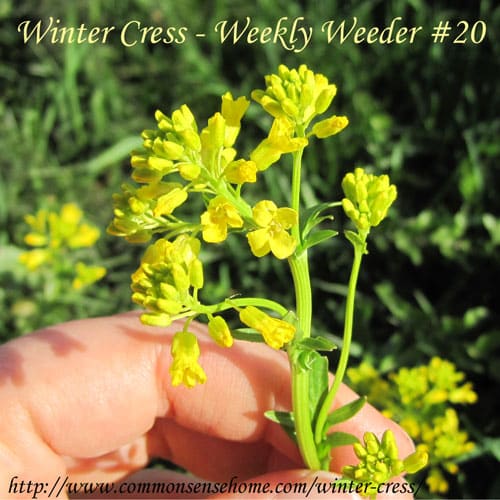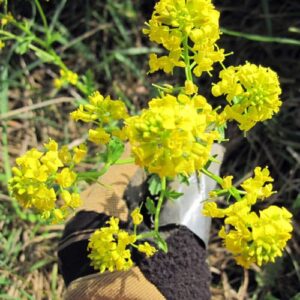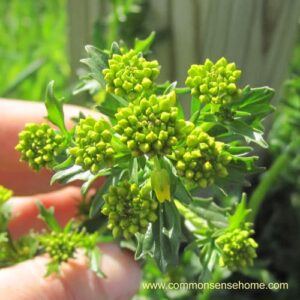Winter Cress – Weekly Weeder #20

Today’s featured plant is Winter Cress, Barbarea vulgaris.
Winter Cress is also known as Bittercress, Common cress, Indian posey, Land cress, St. Barbara herb, Scurvy cress, Upland cress, Yellow rocket.
Range and Identification of Winter Cress
Although native to Asia and Europe, winter cress is now naturalized in much of North America. It can be found throughout most of the United States and Canada (see map).
It can grow in sandy or loamy soil, and prefers full sun and moist ground. It appears in most spots other weeds might appear in, such as open fields or along roads or railroad tracks.
The plant grows from 1 to 2 feet tall. Leaves alternate along the stalk, and are coarsely toothed and roughly club-shaped. Leaves are 3-5 inches long, and the higher ones tend to attach to the stem. (Wildflowers of Wisconsin)

The flowers are yellow (like buttercup or dandelions), and are regular in shape with four petals. They grow in clusters near the top of the plant. The plant is biennial (it requires two growing seasons to complete its life cycle). During the first growing season it produces mainly foliage. In its second year it will flower and set seed. It is often one of the first plants to flower in spring.

When I was a little girl, I remember certain fields being full of this plant, especially low lying ones. Sometimes there would be another sea of yellow right on the heels of the dandelion blossoms.
Winter Cress as Food for Wildlife and People
Winter Cress flowers is important as an early season source of nectar and pollen for bees and some butterflies. Its seeds are eaten by some birds such as doves and grosbeaks.
Before the plant blossoms (for second year plants) or after the first fall frosts (for first year plants), the leaves are edible as salad greens, although bitter. Once it has blossomed, the leaves become so bitter as to be inedible. Caution is advised in eating the raw plant, only small amounts – 1 tbsp. chopped leaves or less. Unopened blossoms (buds) are edible if cooked lightly in a manner similar to broccoli. The plant is rich in vitamins C and A. I tried some of the unopened buds raw this spring, and they do taste a bit like broccoli – really strong, stinky broccoli. Cooking is highly recommended!

Medicinal Uses of Winter Cress
The plant is said to possess anti-carcinogenic (anti-cancer) properties. Cherokee Indians used a tea brewed from the aerial parts as a blood purifier. It is also used as an appetite stimulator (bitter greens). Europeans used poulticed leaves to treat wounds.
Winter Cress also works as a mild antitussive (cough suppressor), a bitter (aids digestion), and may have a slight diuretic effect (helps get rid of excess water).
As always, any medical information is for informational purposes only. Always exercise caution when using any wild plants, as allergic reactions and drug interactions are rare but may happen. Always make sure to clearly identify your plants and harvest from a clean area. Visit this post to see my favorite wildcrafting books.
If you've enjoyed this post and would like to see more, please take a moment to share, Like or Pin It. I know a number of readers enjoy these posts, but they do tend to get less traffic than many other types of posts, so it really helps if you take a moment to share.
